Blog
Rev Gav
Fluid Church – Eat, Pray, Love
Preamble
I have a dislike for long, boring documents, so this is not going to be a long, boring document (I hope). Let’s find out!
I am a church visionary, strategist, and activist. This means that — with humility and under the guidance of the Spirit — I see where the church should be going, make a plan on how to get there, and then get on and do it!
I have five years of experience in Bermuda in what is a traditional ‘attractional’ church. When I mean attractional, I mean that our primary mission-strategy has been to get people through the door on a Sunday, and this, we have done very well. The church has doubled in its congregation size with nearly all the new members being first-time Christians with young families (unchurched) or older people returning to the faith (dechurched). This has been achieved through the implementation of specific strategies in terms of style, content, relevance, format, provision, and so on. You can feel a ‘but’ coming can’t you? So here it is…
BUT… attractional church still doesn’t scratch where many people are spiritually itching. We have had many people come through the doors, stick with us for a bit, then kinda drift away. The reason for this is that our focus has been on attracting people to the Sunday thing rather than building community.
What I hope to do with this document is cast a vision for a new way of being church, and it pulls together many strands of discontent with our current model of church and the needs of the community. Are you ready to take the ride? Let’s go!
Fresh Expressions of Church
Coming to Bermuda five years ago I was gobsmacked that there was and still is really no knowledge or understanding of Fresh Expressions of Church. In the UK, the Church of England and the Methodist Church have been pioneering fresh expressions of church for 25 years!
A fresh expression of church is a movement of Christians who establish and grow new Christian communities where they do not yet exist. It is not the same thing as a new style or form of worship in an existing church!
I was a Fresh Expressions Pioneer Minister in the UK and ran two new forms of church — a hip-hop church in a busy city centre, and a café church in an urban priority area (a place where there is identified social need). I also currently, with my wife Helen, run an online church for people that struggle to connect with traditional forms of church.
Did you know that there are over 10,000 Anglican fresh expressions of church in the UK engaging over 50,000 people and that they account for 15% of Church of England Congregations?
As far as I am aware there is not a single fresh expression of church in Bermuda.
The Frustration
I’m frustrated. Grrrr.
Why am I frustrated? Well, as I’ve already mentioned, I’m frustrated because we can’t seem to enable people to ‘stick’ to our traditional forms of church, and I long to see them encounter Jesus and be sustained in that encounter.
I am also frustrated because:
- our traditional church congregations are getting older and smaller in number,
- our buildings are costly and suck all the time and energy out of our congregations with their leaky roofs and insurance premiums that make you weep,
- our buildings are open for two hours once per week — when did I get to be a museum curator rather than a community-builder?
- we put a lot of energy into the Sunday ‘show’ but people don’t seem to grow in their spirituality or knowledge of the Bible (well, not as fast as I would like). I wanna grow disciples!
- of the throw-away single-plastic environmentally-damaging culture here in Bermuda when we’re supposed to be stewards of God’s creation,
- that I went into a café the other day and a coffee cost me over $8. Eight dollars for a coffee. A coffee. Eight dollars. Are you getting that?
- that there is real food poverty here and the church has engaged in some wonderful feeding programmes but this outreach again has not (especially) built community. Can you tell I’m all about building community?
- that there is pretty much only one (or two) openly affirming and inclusive churches where people feel safe and loved and wanted by God,
- there are few places people can hang out and just ‘be’ to make friends, meet new people, and get a coffee that doesn’t cost $8,
- there’s a whole heap of people out there that the church isn’t reaching, yet nearly every church (and there’s a lot of them) is doing exactly the same thing, just in different styles and in different venues.
That’ll probably do.
Sure, we can mess with our current forms of attractional church, but I can’t help thinking that to do so is like rearranging the deckchairs on the Titanic.
Don’t get me wrong, St. Mark’s has reached a LOT of people, and despite a large number of elderly members passing away, we have still only grown our membership by a small amount over five years. Now, I know it’s not only about numerical growth, but also about spiritual growth, but for every person we’ve engaged with, I can think of ten that we couldn’t hold on to — why? because church just isn’t scratching where they’re spiritually itching.
Frustrated? Yep.
A large ball of gloop…
Like all good vision documents the writer first begins by communicating the need, then provides a solution. Well, I’ve already banged on about the need, and the solution? Well, we need to follow the lead of the Spirit, but what I’m going to do is throw a large lump of mud against a wall and see how much sticks. To make this large ball of gloop, I’m going to draw on several points of life-experience, things I’ve thought, “That’s a good idea!” and mould them all together into a rounded projectile. Will it stick? That’s not for me to say, but perhaps, just perhaps, it will make someone think. Right now, nothing is off the table, and if you are locked into a traditional churchy way of thinking, this may well require for you to make what psychologists call a ‘paradigm shift’. Ready?
What could a fresh expression of church look like in Bermuda?
1. Food
As I type this, I just snacked and munched on a slice of my wife Helen’s home-made sourdough slathered with home-made butter. It was utterly delicious and I have probably just spoiled my lunch.
We need to do church focused around food and hospitality. It’s a no-brainer, oh, and Jesus did it.
In people’s homes, people gather in kitchens. We all eat, and we all love to eat. How come when the church runs a Sunday service, 40 people show up, but when they run a Fish Fry, 200 people turn up? It’s not rocket science!
At St. Mark’s we’ve run a weekly supper club. No spirituality other than a said grace at the beginning, but the little community has grown. They look out for each other pastorally, have encouraged each other in their walk with Jesus, and all have become more committed members of the church. That last bit is worth reflecting on.
Back in the UK I ran a café church. Apart from a kitchen manager, it was staffed by a team of volunteers, some of whom were not Christian. Every morning, before we opened our doors, we would gather in the kitchen to pray. A local woman called Sue started volunteering, and each week as we prayed Sue would remain silent, then one week she asked us to pray for her son, which we did. A few weeks later we were about to pray when she burst out in prayer, “Jesus! We pray to you!” I cried. This was a woman who had never been to a church service in her life, never been on an Alpha Course, never responded to an altar call, but who had met Jesus. Just think about that for a moment!
In Lyme Regis (incidentally, twinned with the town of St. George in Bermuda), one of our favourite haunts was the Town Mill Bakery. This venue had long communal tables and benches that helped foster conversation and they had a genius idea. Their USP (Unique Selling Point) was that for a small payment you could eat as much fresh bread or toast as you could eat. The communal tables had large bowls of butter and jam, and then on one side of the building were large loaves of bread and a couple of those conveyor-belt style toasters. You simply sliced your bread and put it through the toaster. We’d take the kids for breakfast and they could simply help themselves. Genius. Oh, and the owner made a fortune. Hold this thought!
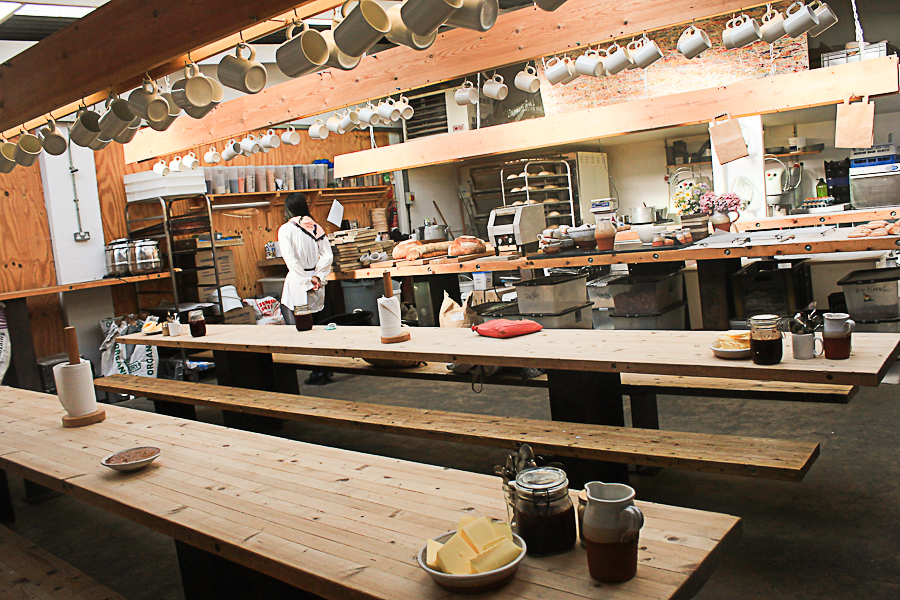
Communal tables at The Town Mill Bakery with open-plan kitchen
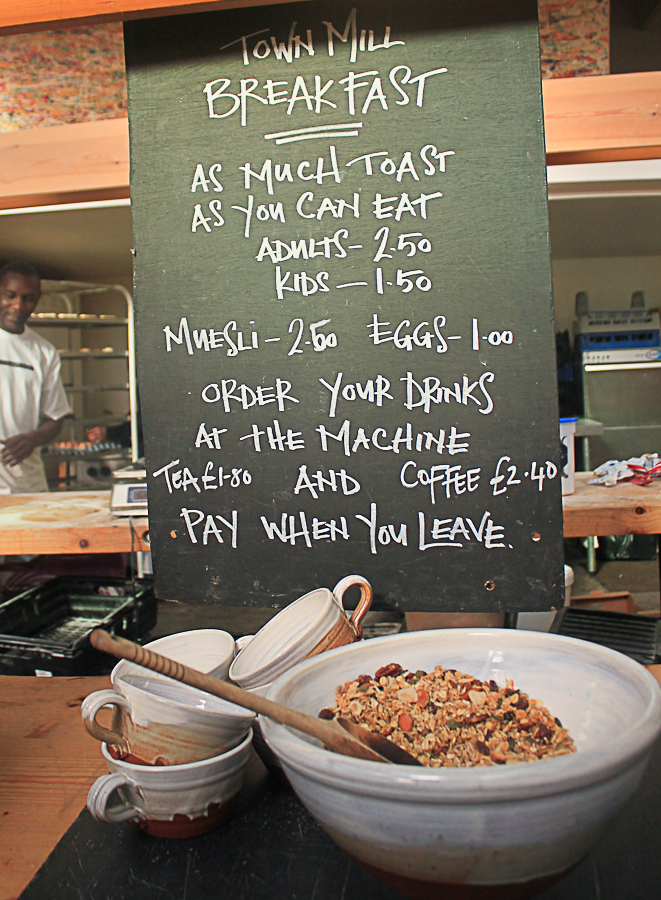
All you can eat toast! Payment is by honesty system!
Whatever fresh expression of church we build it’s going to be focussed around food — high quality, yummy, affordable, and healthy food. There is a technical term for this, and it’s French. It’s called a café.
2. Rhythm
Over the years I have taken retreats at several different monasteries, convents, and other religious communities. What strikes me about these communities is that communal worship is not Sunday-focused but woven into daily life. Some, at the summon of a bell, gather five or more times a day, and this worship gives rhythm and pattern to the life of the community.
One of the things we discuss (in gentle, calm, measured voices), in our traditional churches is the time of our Sunday worship. Earlier tends to suit those with small children, later suits those who are older, and of course, Sunday mornings do not suit anyone with any child or adult engaging in any kind of sporting activity!
I recently undertook a quick survey of the best time to hold worship — especially for families with school age children — and do you know when it was? Saturday afternoons between midday and about 2pm!
Culture has changed and, today, there is no one-size-fits-all time to gather that suits everyone. So, what if we didn’t only worship on a Sunday? What if we engaged in a pattern of worship every day, and multiple times a day, for example, morning, lunchtime, and evening? And what if those times coincided with meal-times — breakfast, lunch, and supper? You can see where this is going right?
Now, I’m not talking about a 90-minute worship with fourteen hymns and a 40-minute sermon! I’m talking about a simple act of worship with which all could engage that lasts, say, 15 minutes — one that could be led by anyone… and that leads us nicely onto the next globule to add to our ball of gloop.
3. Leadership
Does a church really need a single, all-dancing, multi-talented full-time priest or minister? I hope you’ve not fainted. Okay, hear me out.
Many of the Christian spiritual retreats I have attended have been led by visiting leaders and the weeks have been themed, sometimes around a book of the Bible, or a spiritual practice, or an activity. Indeed, I have led weeks at Christian festivals and retreat centres, providing Bible teaching and pastoral care.
What if the fresh expression of church had a full-time, paid organiser or administrator — someone who holds the vision, but then organises leaders to come and lead the Christian community for a month at a time? This is called a Chaplaincy model. The chaplain would come and be part of the community for a month (or two) at a time, leading the worship, being available at set times for one-on-one pastoral support to anyone who asks, and leading groups at set times on specific themes or topics — probably their own area of expertise?
The advantages of this model are numerous! Firstly, it prevents ministerial burnout, fatigue, or the ministry becoming stale. Secondly, it provides a variety and diversity of voices, style, material, and content throughout the year. Thirdly, there will never be a gap in ministry or a need to provide cover, and never an interregnum! How cool is that?
Now, in Bermuda there is something called a Periodic work permit. You do not have to advertise positions that use this permit! It allows someone to come and work for 30 days (extendable to 60 days) at a time for no more than six months in a year. But… get this, it can be issued, not just to an individual, but to an organisation! In other words the permit can be used for one person at a time but it does not need to be the same person who uses it. Two permits and you have the whole year covered.
(Note: Insurance-wise, on-island insurance is too expensive and cumbersome to organise for such a scheme, costing $600pcm and it can take considerable time to get someone registered for the month they are on island! BF&M recommend travel insurance organised independently by each pastor.)
So, why not have an organisation that has a list of pastors/ministers/retreat leaders that could come and serve for a month at a time? No job-advertising required and fresh input on a monthly basis. Sounds good huh?
If the church has a manse, then all they need to do is ensure one room is available and other rooms could be rented out or used by the community. The community wouldn’t need to pay for a car (if city based), but they would need to pay for flights and an honorarium. Bermuda is in the very enviable position that it is a very desirable location. Oh, and food… remember — the monthly leader can get three meals per day because we’re doing this fresh expression around food!
There is some precedent for this in the past, as I believe Willowbank used to run something along these lines, but it’s a very common thing, especially in chaplaincies around the world. For example, the Anglican Chaplaincy in Santiago does exactly this.
4. Inclusivity
Another thing us churchy types think about is how inclusive or non-inclusive a church is — especially here in Bermuda. Well, if you’re running a publicly accessible venue that is centred around food, well, surely all are welcome? No-one in a café asks you if you are gay, straight, trans, or bigender (goodness, at least I hope not!).
Of course, values are important, and Bermuda desperately needs spaces that are inclusive, affirming, and welcoming to all, no matter what race, sexuality, sex, gender, age, social class, or ability. This model of church is inherently inclusive! Also, it’s much easier to walk into a café than a church — ask any non-churchy-type, which leads me nicely into the next section…
5. Mission-shaped Church
If our primary mission strategy has been to get people through the doors on a Sunday, what we are doing is inviting them to the ‘end product’ — worship. We are asking them to abide by a whole set of church rules about where to sit, stand, and what to say, sing ‘I love you Jesus’ songs or 18th Century hymns, and undertake strange rituals and religious ceremonies to worship a God they probably haven’t yet got to know! On what planet is this a good mission strategy?
One of the biggest wins about this model is you are not trying to ‘attract’ people to a service of worship. Sure, branding, marketing, and welcome are all important, but this Christian community is built around a mission to provide healthy, affordable food, and a safe space to build relationships — a place where people can come and be fed both physically and spiritually. This would be a place where kids can get a good breakfast, the elderly can come and chat and find companionship, and so on.
Such a fresh expression needs volunteers to help make it happen — people who join the community, but, and this is the important bit… you are inviting them, not to a worship service, but to join in with the mission of God in the world!
6. Seminars
So what about biblical teaching? When would there be a sermon? Good question. The answer is not necessarily in the three daily acts of worship!
The chaplain would lead a short daily teaching session followed by a time of discussion that anyone could attend. This could (but not necessarily) be filmed and made available to all online so that people could watch and engage in their own time. This would provide people with relevant input, and the Christian community (church) would soon build up a library of content that would become a wonderful resource.
Now, of course, for any one pastor or leader to do a daily ‘sermon’ or ‘homily’ is a big ask, but remember, these people are coming for a month at a time, and so preparation would be done in advance of their arrival, plus there would be time built into their schedule for both downtime and prep time.
Right now, I write a daily devotional, a weekly Bible Study, and at least one weekly sermon! It is very possible!
Okay Gav, so what does it ‘actually’ look like?
We’re kinda talking about creating a monastic urban community built around a café rather than just another Sunday-focused traditional church, so let me paint a picture of what something like this might look like — and to make it more fun, let’s consider working with a likely (and present) scenario — a traditional church with a dwindling congregation and an existing building that is ready to take the risk to do something radical and new! Ready?
So… imagine…
The Building
A church has a beautiful building in the city-center. The congregation is struggling, and like most churches, the population is aging and growing smaller. They do have a dedicated core of members and enough impetus to keep things going, at least in the short-term. They have come to a watershed moment in the church’s history, perhaps finding themselves in an interregnum, or they have come to the simple realisation that their church is not ‘thriving’ in the way it did fifty years ago. They have a heart for mission and to reach the unchurched.
With nothing to lose, they decide to adopt Rev Gav’s radical model of a fluid café church.
The church has reconfigured their worship space to become a large, trendy-style café and bakery. Most of the pews have been removed and reworked to provide seating at long communal tables. Over to one side is a lending-library area with second-hand Christian books and commentaries. There is a kids play and seating area with bean bags, books, and toys. On one side there is an open plan kitchen area and servery. There is also a long wooden self-serve area where food for purchase is placed. By the door is a simple till and payment area. There is also a small Christian bookshop and gift area where people can purchase Bibles and other Christian materials.
In the UK, many large venues have been converted into eateries. The JD Wetherspoon chain have converted old cinemas, and the Lounges group create a retro feel in older, more traditional spaces. But importantly, lots of churches, particularly in cities such as London run cafés. Yes, it can be done!
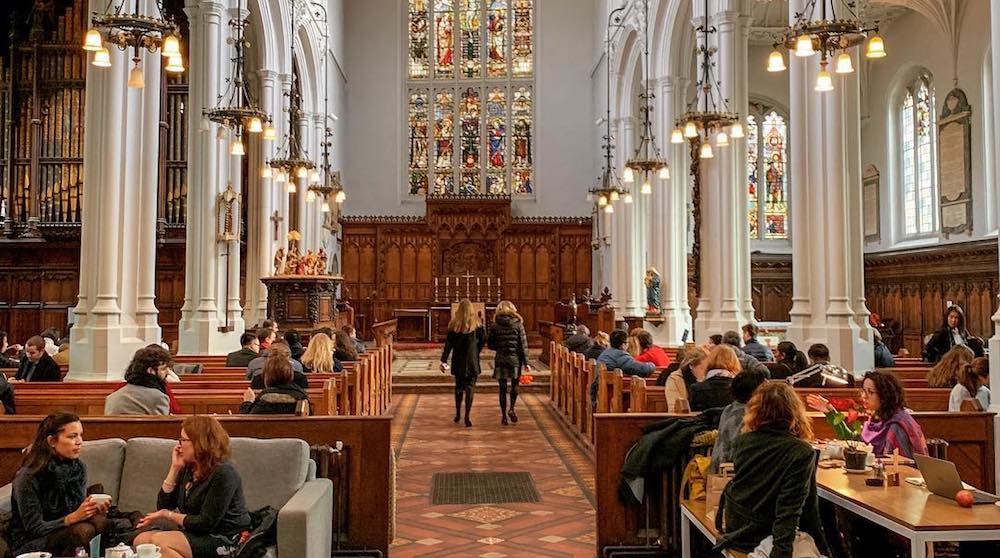
Saint Mary, Aldermary, London UK
Branding
Seeking to be relevant and cross cultural boundaries, the church community is not called St. Bartholemew’s or whatever trad name it has, but is rebranded. Let’s call it the FAB Community Bakery.
The idea is that The FAB Community Bakery becomes an attraction in its own right — not an ‘attractional church’ but immensely popular with locals and tourists because of its vibe, great food, and community feel.
Staff
The Church community pays a full-time administrator and probably two people to manage the café — to cover each day of the week in shifts . Each role runs one or more teams of volunteers. Note: Volunteers do not have to be church or community members! That’s the point, remember? We are inviting people to join in with the mission! However, of course, volunteers will be expected to join in with and adhere to the values of the Christian community.
Volunteers, staff, and chaplains eat for free!
Staff (including volunteers and the chaplains) all wear T-shirts with the branding and logo so they are clearly and easily identified.
The Food
The café is open from 7.30am to 8pm each day — but, importantly, only serves drinks and snacks at certain periods, thus not requiring a kitchen manager/cook to be serving food at all times.
The café operates on a simple honesty system and there are no take-out options available (as a general rule). At the end of your meal, you simply tell the teller what you had to eat and/or drink and they tot it up. The food is cheap, fresh, healthy, and the whole system is environmentally friendly — no single-use plastics, no plastic bottles, and no plastic knives and forks! Everything is reusable and reused, and if you really want to take your coffee with you, bring your own reusable cup!
Breakfast and tea is simply loaves of sliced bread, butter, some kind of condiment — perhaps with another simple option (such as muesli at brekkie). Drinks are served or could be self-served at a separate counter with refillable regular filter coffee and tea and water. Help yourself to milk, non-dairy milk, sugar, honey, etc.
Lunch and dinner are something simple, tasty, and healthy. We’re not talking about a whole ‘menu’ of selectable items! When I ran a church café there was soup, one main dish, a kids menu of five simple items for £1, baked potatoes, and toasties. At the Town Mill in Lyme regis, it was soup and one other kind of main — typically one vegan and one vegetarian with bread. The idea with the food would be to start simply and see where it goes.

Hope Chapel in Bristol, UK, does much of their ministry around food. I remember them offering a free breakfast buffet every Sunday and our kids loved it!
Chaplains
Each month (or two if using a periodic work permit) there is a different chaplain who is on site for 6 days per week including weekends. Crossovers of chaplains take place once-per-month, mid-week, with one leaving and one arriving. Remember, there is no ‘Sunday’ focus, but it is likely there will be slightly more engagement over weekends. Of course, chaplains could and should also be sourced on island where possible!
The Chaplain (and volunteers) lead the three daily acts of worship using the community liturgy — relevant, accessible words. Saturdays and Sundays could include an informal communion.
At set times of the day the chaplain is available for one-on-one prayer, and if no-one wants prayer, this time is spent doing prep.
Each day the chaplain also gets ‘downtime’ for themselves.
Each day the chaplain leads a session on that week’s specific theme or topic.
Groups
Each day there would be three ‘group’ times (with one being the chaplain’s input) and a Kids activity time.
Groups could include:
- Bereavement Support
- Music Worship and Prayer
- Hymn time (with requests!)
- Prayer Group
- Bible Study
- Marriage Course
- Parent and Toddler
- Book Club
- Knit and Natter (or Bitch and Stitch)
- Craft activity
- Musical Performances
Kids Activity time could be:
- Homework Club
- Story time
It would be expected that the chaplain would lead one daily Bible reflection or study per day that could be shared online.
Daily Worship
During mealtimes there is an act of worship that lasts 15 minutes. At the start of each meal ‘service’ laminated cards are put out (a bit like a stack of menus in a holder) in the centre of each table with the communal words — there is one set of cards for Morning Prayer, one for Midday Prayer, and one for Evening Prayer. There are also sets of cards for Communion. The words are unique to the worshipping community, relevant, and accessible to all.
Timetable
Each week would be ‘themed’ in terms of the chaplain’s input and would likely follow the seasons of the year — Advent, Christmas, Epiphany, and so on — and probably follow the lectionary readings (depending on the general denomination).
Each week the administrator would publish the forthcoming week’s timetable from Monday through to Sunday displaying what is happening each day.
Here is a snapshot of the weekly themes for the Lee Abbey Community in Devon, UK.
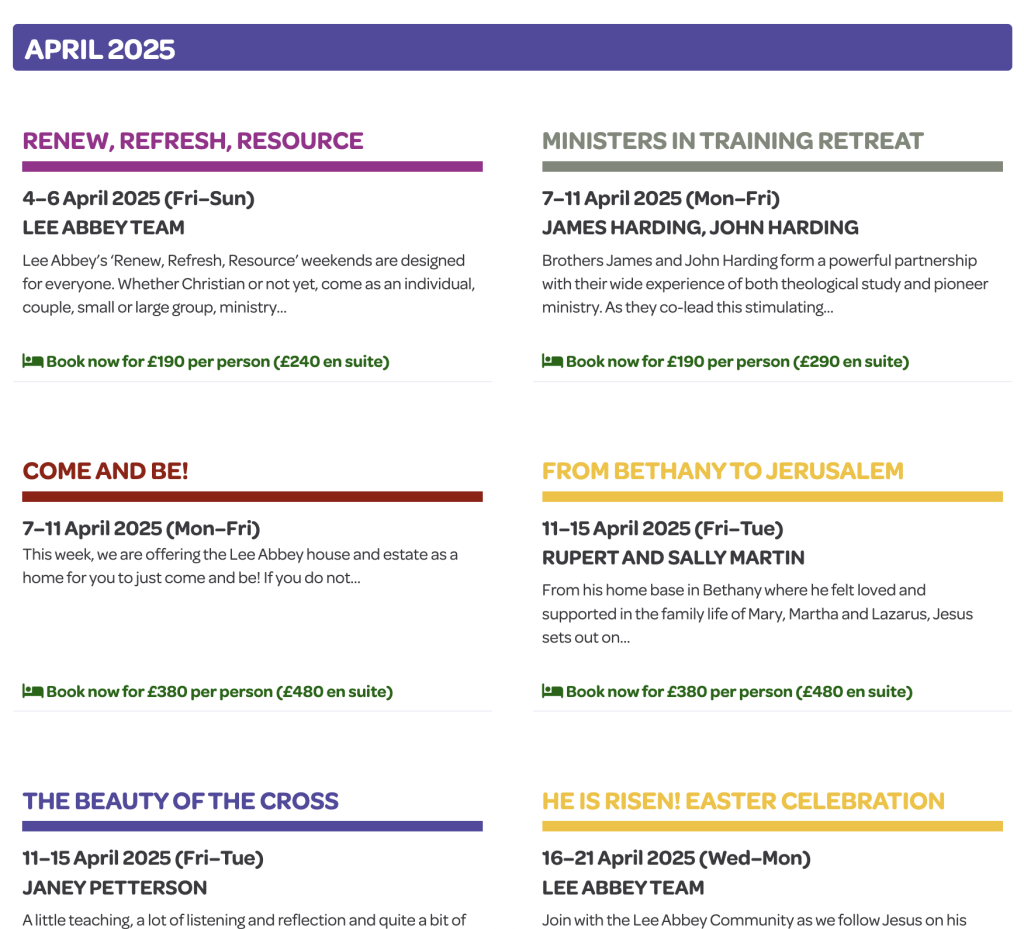
Lee Abbey Christian Community in Devon work on a weekly basis of different speakers, workshops, and themed weeks.
The café would have set and permanent opening times but the groups may change on a weekly basis:
COMMUNITY CAFE OPEN 7.30am – 8pm DAILY
Drinks and snacks served all day.
7.30am – 9am – Breakfast
12pm – 1.30pm – Lunch
4pm – 5pm – Tea
5pm – 6.30pm – Dinner
WORSHIP TIMES
8am – Morning Prayer
12.30am – Lunchtime Prayer
6pm – Evening Prayer
CHAPLAINCY
Would you like to speak to someone in confidence or receive prayer?
Daily between 9am – 10am and 1pm-2pm
THIS WEEK…
This week the theme is God’s Grace led by our chaplain Rev Janet. (Note: This is just a quick idea!)
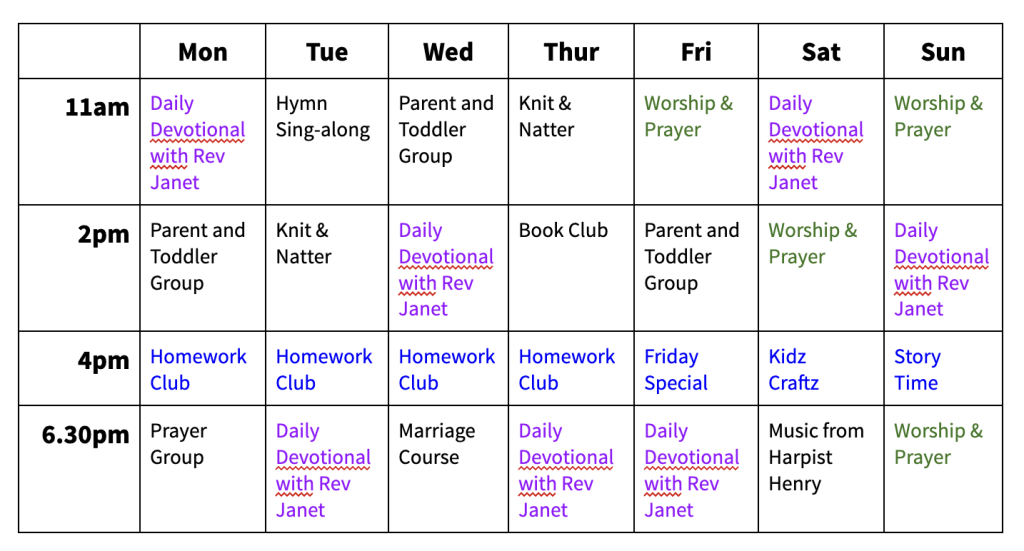
Now, I know you’re thinking, “My goodness that looks full, how could we possibly cover that?” Well… firstly, remember the café is there doing its thing. Also, you have a full-time chaplain who can help organise things. Also… things like a parent and toddler group just needs a parent to get out some toys, and knit and natter, surely there’s someone in your congregation who likes to knit and talk??? Homework club needs no organising, just encouragement for kids to come along, eat some toast, and if they want, do their homework!
I know I’m getting bogged down in detail, but also know there are some of you reading who need the practical details! So here’s an example timetable of how a single day might pan out.
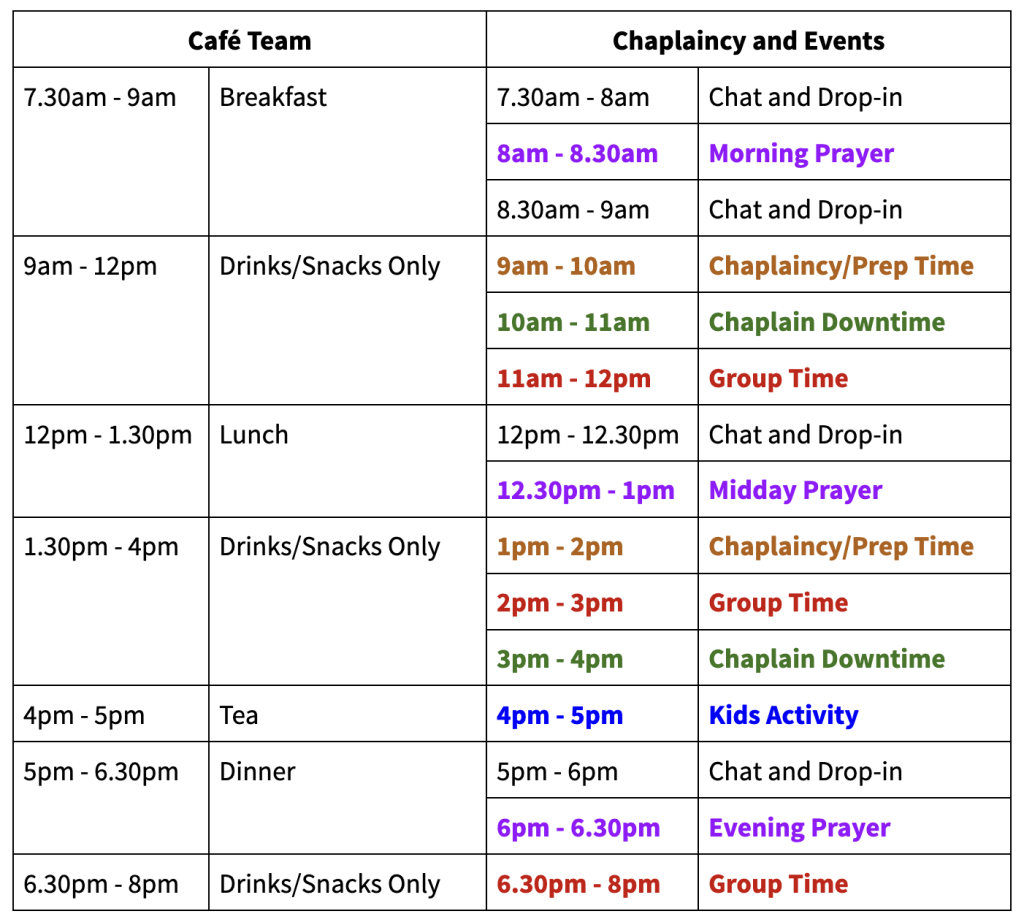
Somewhere to Gather
I can’t emphasise enough the need for places for people to gather, particularly the lonely and elderly — somewhere they can be, and find friendship, companionship, and support. We need a church that crosses boundaries and is accessible, particularly to the unchurched (and dechurched).
And Finally…
I’ve probably written enough. This is not a prescriptive plan but something to fire the imagination. I often ask myself, if I was starting a Christian Community from scratch, what would it look like? And I think it would look something like this!
Heaps of Peace
Rev Gav




 and then
and then